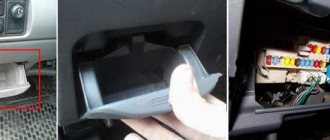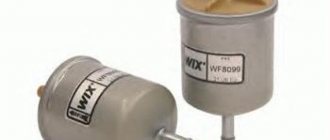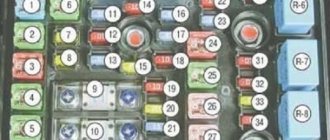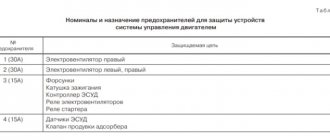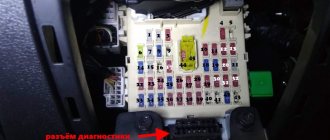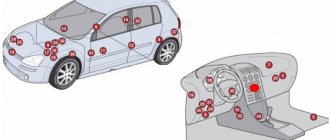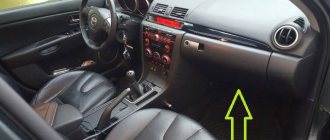Fuses and relays are responsible for the correct and safe operation of Almera Classic electrical appliances. Moreover, each component has a specified current rating and is mounted in a separate installation kit. Let's consider where the individual protective devices are located and the coverage area. We will also figure out how to replace them correctly.
Fuse box in the passenger compartment
The relay is on the back of the interior fuse box.
The Almera Classic interior mounting block has the most common installation location, in the space under the steering wheel closer to the driver's door. Mounted in a specialized glove compartment. If it is necessary to replace additional relays, you will need to remove the unit from the seat, since they are installed on the rear and ensure the functioning of the following devices:
- 1 – air conditioning complex;
- 2, 3 – ignition;
- 4 – auxiliary electrical mechanisms.
Almera Classic fuse box in the cabin
The front side of the cabin mounting block consists of the following devices with fuse links (most of which have a rated current of 10A - 4, 5, 6, 8, 10, 13, 14, 15, 17, 18, 20-26 ):
- 1, 2 – electric motor of the heating complex (15A);
- 3, 12 – reserve;
- 4 – turn signals;
- 5 – reverse lamp, instrument panel lighting;
- 6 – ABS;
- 7 – wipers (20A);
- 8 – heated front row seats;
9 – fuel pump (15A);
- 10 – auxiliary receivers;
- 11 – heated rear window (20A);
- 13 – headlights;
- 14 – injectors of the fuel mixture supply complex;
- 15 – clock, dashboard;
16 – cigarette lighter fuse (15A);
Fuse box Almera Classic in the cabin
- 17 – heating and adjustment of external mirrors;
- 18 – lighting of the interior cabin space;
- 19 – central lock (15A);
- 20 – interior lights;
- 21 – multimedia;
- 22 – power unit ECU;
- 23 – airbags;
- 24 – air conditioner;
- 25 – automatic transmission;
- 26 – ignition.
Also, relay devices are installed on the outer surface to ensure operation:
- 1 – window lifters;
- 2 – rear fog lights;
- 3 – central lock.
The relays on the front side of the block are located to the right, numbers are assigned to them from top to bottom
Location and electrical diagram
In the Nissan Almera classic n16 there are several fuse blocks responsible for the operation of electrical equipment.
One of them is located in the car interior, the other two are in the engine compartment. On the front side of the power supply unit, located in the vehicle interior, there are several fuses (hereinafter referred to as fuses) and relays.
On the other side of the device there are three more main relays.
There are two power supplies in the engine compartment. One of them contains relays, and the other contains only fusible devices. Below are diagrams of all three blocks, as well as a description of the fuses in them.
PSU in the cabin
What are these elements responsible for? Below is a table with the designation of each PP.
You may also have noticed several relays whose purpose is not described in the table. They should be highlighted separately, since the relays are designed for more powerful voltage consumers.
| Number | Purpose |
| R1 | This component ensures the functionality of the headlight lamps, that is, it is responsible for both low and high beam. |
| R2 | The second component by number ensures the functioning of the throttle valve. If it fails, the operation of the car will be incorrect or impossible. |
| R3 | Responsible for the operation of electric windows. |
| R4 | Ensures the functionality of the rear fog lamps. |
As for the device number 22, which is responsible for the functionality of the cigarette lighter. In Nissan Almera classic n16 models, cigarette lighter failure is a common problem. It can even be called a disease, since many motorists encounter this malfunction.
If you notice that the cigarette lighter is not working, first check the functionality of the fuse. Perhaps that is where the problem lies.
However, many car owners use their cigarette lighter as a power source for various electrical consumers.
In particular, these can be video recorders, special air fresheners, DVD players and laptops.
Of course, even with a voltage converter, the cigarette lighter is simply not able to cope with such a task. So if it is the PP that fails, then you can consider yourself lucky. Otherwise, you will have to change the cigarette lighter, even worse if this causes the mounting block itself to burn out.
As you remember, at the beginning of the article we mentioned that there are also several relays on the back of the power supply, which is located inside the car. If the block is completely dismantled, the relays will look approximately as shown in the photo.
| Number | Purpose |
| R1 | Ensures the functioning of the ignition coil. If it fails, starting the engine will be impossible. |
| R2 | Responsible for the operation of the engine supercharger. |
| R3 | This device ensures the operation of additional voltage feeders, that is, in fact, all electrical accessories. |
PSU in the engine compartment
- First, let's look at the diagram and description of the power supply with fusible devices, which is located in the engine compartment between the battery and the engine.
Diagram of the power supply located in the engine compartment, between the battery and the internal combustion engine
Description of the components of the power supply installed in the engine compartment, between the battery and the engine- Next, we will describe the diagram of the mounting block with the relay, which is installed in the same place, in the engine compartment, only to the left of the engine, if you stand facing the hood.
| Number | Purpose |
| R1 | Responsible for the operation of the third radiator fan relay of the cooling system. |
| R2 | Without this element, the operation of the front fog lamps will be impossible. |
| R3 | This component is responsible for the operation of the air conditioner. |
| R4 | Steering wheel signal relay. |
| R5 | Also ensures the functionality of the radiator fan. |
| R6 | Responsible for the operation of all headlights and lights in the vehicle interior. |
| R7 | The operation of the starter depends on this relay. |
Block in the Almera classic interior
It is located in the instrument panel on the left side, behind a small box.
Scheme
Description
| 1 | 15A Electric heater motor |
| 2 | 15A Electric heater motor |
| 3 | Reserve |
| 4 | 10A Direction indicators |
| 5 | 10A Instrument cluster and reversing lights |
| 6 | 10A Anti-lock brake system |
| 7 | 20A Windshield wipers |
| 8 | 10A Heated front seats |
| 9 | 15A Fuel pump |
| 10 | 10A Additional consumers |
| 11 | 20A Heated rear window |
| 12 | Reserve |
| 13 | 10A Headlights |
| 14 | 10A Fuel injection nozzles |
| 15 | 10A Instrument cluster, clock |
| 16 | 15A Cigarette lighter |
| 17 | 10A External rear view mirrors |
| 18 | 10A Interior lamp |
| 19 | 15A Door locks |
| 20 | 10A Brake lights |
| 21 | 10A Car Radio |
| 22 | 10A Engine control system |
| 23 | 10A Airbags |
| 24 | 10A Air conditioner |
| 25 | 10A Automatic transmission control system |
| 26 | 10A Ignition system |
The cigarette lighter is controlled by fuse number 16 at 15A.
Face Relay
- power window relay;
- rear fog lamp relay;
- central locking relay
Rear side relay
- air conditioning relay;
- 1st ignition relay;
- 2nd ignition relay;
- accessory relay.
Fuses and relays in Nissan Almera N16
In total, the car has 2 fuse blocks and 1 relay block. These diagrams and location are only suitable for the body - N16 production from 2000, 2001, 2002, 2003, 2004, 2005 and 2006.
- 0:280
- 1:785
The cabin unit includes several fuses and relays. On the reverse side of this block there are 3 more important relays. The remaining two are located under the hood. One contains only relays, the other only fuses. The diagram and tables provide a precise description of all blocks. Location of blocks and decoding of their fuses.
- 1:1413
- 1. Fuse box in the cabin
- 1:1477
To access it, open the driver's door, in the lower panel on the left, open the mini glove compartment, also known as the cover of the unit. We take out the entire pocket from the panel.
- 1:1760
- 2:2265
- 3:504
- Photos of blocks from different cars to compare the positions of the fuses.
- 3:647
- 4:1152
- 5:1657
- Scheme of the first block with numbering for the table below
- 5:1752
1 - 10A Mirrors 2 - 10A Brake light bulbs 3 - 15A Electrical socket 4 - 7.5A For additional electrics 5 - 000 Hazard alarms and turn signals 6 - 10A For additional electrics 7 - 20A Heated rear window 8 - 10A Oxygen sensor 9 - 10A Additional electrical package 10 - 10A Electrical package 11 - 10A Automatic transmission controller 12 - 10A Electrical package (i.e. all control of all turn signals, backlight and main power supply for the dashboard, illumination of the panel where the stove is) 13 - 10A Interior lamp 14 - 15A Interior fan electric motor (heater /air conditioner) 15 - 10A Air conditioning 16 - 15A Interior fan electric motor (heater/air conditioner 17 - 10A Fuel injection system 18 - 10A Airbags 19 - 20A Additional electrical accessories 20 - 10A Engine controller 21 - 10A Start signal 22 - 15A Cigarette lighter 23 - - - Not used 24 - 20A Additional electrical package 25 - 20A Windshield wiper 26 - 7.5A For additional electrics 27 - 15A Front and/or rear window washer (on the steering column switch) 28 - 15A Rear window washer 29 - 15A Fuel pump 30 - 10A Speedometer, tachometer, temperature and fuel level indicators 31 - 10A ABS 32 - 10A Reserve 33 - 15A Reserve 34 - 20A Reserve
- 5:4018
- Relay
- 5:13
- R1 Headlight relay R2 Throttle control relay R3 Power window relay R4 Rear fog light relay
- 5:259
- On the back of the cabin unit, if you pull it out completely, there will be a plate with 3 relays.
- 5:431
- 6:936
- Photo and diagram of the additional plate
- 6:1008
- R1 Ignition relay R2 Supercharger motor relay R3 Additional equipment relay (electrical accessories)
- 6:1211
- 2. Fuse box in the engine compartment
- 6:1292
Fuses and relays under the hood of Almera Classic
In the engine compartment of the Almera Classic, sets of fuses and relays are mounted. The first is directly next to the battery on the left side and consists of the following elements (mainly with a rated current of 15 Amps - 4, 5, 9, 17, 21, 22, 23):
Location of fuse boxes under the hood
- 1, 2, 3, 8, 15, 16, 28 – reserve;
- 4 – signal;
- 5 – throttle valve regulator;
- 6 – dimensions (10A);
- 7 – electronic power unit control unit (10A);
- 9 – ignition coils;
- 10 – ignition switch (30A);
- 11, 12, 13 – ABS (20A);
- 14, 29 – first and second main protective element (65A);
- 17 – heated windshield;
- 18 – ABS (5A);
- 19 – rear fog lamp (10A);
- 20 – dashboard (20A);
- 21 – front fog lights;
- 22, 23 – high and low beam;
- 24 – generator relay (100A);
- 25, 26 – radiator cooling fans (30A);
- 27 – window lifters (30A).
Fuse numbers in the engine compartment block
The relay part of the engine compartment is mounted on the right wing of the Almera Classic. It includes the following relays:
- 1, 3 – low and high beam;
- 2 – anti-theft kit;
- 4, 6, 10 – radiator cooling fans;
- 5 – connector for diagnosing the anti-lock brake system;
- 7 – signal;
- 8 – air conditioner;
- 9 – automatic transmission.
Relay numbers in the block under the hood
Purpose, types and colors of electrical fuses
"Nissan Almera Classic": technical characteristics and description of the car
Almera G15 fuses are a protective element of various electrical equipment from the following phenomena:
- short circuits;
- current overloads.
Their circuit can be made in one, two or three blocks. Moreover, each of them is responsible for the operability of the equipment complex, and a separate element is responsible for the protection of a specific device.
The following types of fuses are distinguished:
Plug fuses
Plug-in - the most common, consist of two plugs, between which there is a fuse-link for a certain amount of current. It is closed with a plastic casing. When the maximum value of the current flowing through the insert is exceeded, it burns out.
Bimetallic - in the specified type of fuses, the fuse-link is replaced with bimetallic plates with silver-plated contacts that fit tightly to each other. If an abnormal mode occurs, the plates heat up and open. Their further contact will occur after the metal has cooled.
Plug and bimetallic fuses with spring
Spring bimetallic - the principle of operation is identical to the previous type. The difference is that the bimetallic plates do not return to their original position on their own. This is achieved by introducing an additional spring into the design, which holds the plate in the off position. To restore the electrical circuit, you will need to press a button that will release the spring.
Fuses are produced with different current ratings. At the same time, manufacturers give each denomination a specific color. In most cases, the following colors are used:
- black – 1A;
- gray – 2A;
- purple – 3A;
- brown-yellow – 5A;
- dark brown – 7.5A;
- red – 10A;
- blue – 15A;
- yellow – 20A;
- white – 25A;
- green – 30A;
- orange – 40A;
- blue - 60A;
- brown – 70A;
- light yellow – 80A;
- lilac – 100A.
Color shades may vary
Correct replacement of fuse links
Before replacing fuses, disconnect the negative terminal of the battery.
Before replacing the Almera Classic protective devices, you will need to dismantle the old element and make sure it is unsuitable. For this, special plastic tongs are used. In most cases, damage to the fuse link is visible to the naked eye. In rare cases, a continuity test using a multimeter is required. You will also need to purchase a new fuse or relay. It is necessary to select the appropriate rated current of the product. It is written on the component itself, or determined by the color scheme. Replacement is carried out in the following sequence:
A poor quality fuse may cause a fire.
- To check the quality of the new protective element, you should connect the fuse link directly through the battery using two wires. It must withstand the load without showing signs of melting;
- It is necessary to establish and eliminate the cause of burnout of protective devices. Otherwise, the new element will burn out or the electrical equipment will burn out;
- Disconnect the negative terminal of the battery;
- Remove the burnt out protective element and install a new one;
- Connect the battery terminal and check the functionality of the equipment.
Recommendations for diagnosing electrical equipment
The main causes of malfunctions in the operation of car electrics: contact failures in circuits, oxidation of terminals on connectors, failure of relays and blown fuses or fuse links. Symptoms of violations can be different - from short circuits due to insulation damage to the shutdown of devices, components (one or several at once) and failure to start the engine. Serious problems in an electrical circuit with powerful consumers can cause the wiring to ignite and lead to a fire, so when even minor faults are detected, it is important to diagnose the entire electrical circuit.
The search for the cause of the malfunction begins with the identification of working elements by the method of exclusion until the detection of a non-working unit (relay or blown fuse). If several consumers do not work, then contact to ground may be broken, since they can all be connected through one circuit.
To identify problems in circuits, special diagnostic equipment is used: a voltmeter, a tester, a set of connecting wires with alligator clip terminals, or a probe with an indicator and a 12 V test light. Before checking, carefully study the circuit and test for the presence of voltage, starting from the source power supply to the fuse block connector, first checking the integrity of the fuse links.
Nissan Almera fuses >
The electrical circuit of the Nissan Almera Classic is arranged as a single-wire circuit: the positive terminal of all energy consumers is connected to the body, the negative terminal is connected to ground. The components and mechanisms are powered while the vehicle is moving from the generator, and when the engine is not running - from the battery.
All circuit circuits are controlled through mounting blocks with relays and fuses, which are designed to protect against short circuits and power surges when the ignition system is turned on.
In total, three blocks are installed on the Almera Classic, each of which is responsible for the operation of a specific circuit and provides power to the elements using a multi-wire circuit.
DISASSEMBLY OF A BROKEN ELEMENT
It’s another matter if after such an event the energy source has not been restored. In this case, it will be necessary to disassemble the element itself. First, you can do a preliminary check:
- You should get to the back of the nest.
- Remove the connector.
- Connect the light bulb.
- Turn the key to ACC position.
If the light comes on, dismantling will be necessary. In this regard, a reasonable question arises: how to remove the cigarette lighter on a Nissan Almera Classic?

